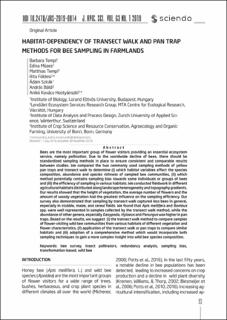Please use this identifier to cite or link to this item:
https://doi.org/10.21256/zhaw-3192Full metadata record
| DC Field | Value | Language |
|---|---|---|
| dc.contributor.author | Templ, Barbara | - |
| dc.contributor.author | Mozes, Edina | - |
| dc.contributor.author | Templ, Matthias | - |
| dc.contributor.author | Földesi, Rita | - |
| dc.contributor.author | Szirák, Ádám | - |
| dc.contributor.author | Báldi, András | - |
| dc.contributor.author | Kovács-Hostyánszki, Anikó | - |
| dc.date.accessioned | 2019-07-04T10:35:34Z | - |
| dc.date.available | 2019-07-04T10:35:34Z | - |
| dc.date.issued | 2019 | - |
| dc.identifier.issn | 2299-4831 | de_CH |
| dc.identifier.uri | https://digitalcollection.zhaw.ch/handle/11475/17406 | - |
| dc.description.abstract | Bees are the most important group of flower visitors providing an essential ecosystem service, namely pollination. Due to the worldwide decline of bees, there should be standardized sampling methods in place to ensure consistent and comparable results between studies. We compared the two commonly used sampling methods of yellow pan traps and transect walk to determine (i) which habitat variables affect the species composition, abundance and species richness of sampled bee communities, (ii) which method potentially contains sampling bias towards some individuals or groups of bees and (iii) the efficiency of sampling in various habitats. We conducted fieldwork in different agricultural habitats distributed along landscape heterogeneity and topography gradients. Our results showed that the height of vegetation, the average number of flowers and the amount of woody vegetation had the greatest influence on the sampling efficiency. Our survey also demonstrated that sampling by transect walk captured less bees in general, especially in stubble, maize, and cereal fields. We found that Apis mellifera and Bombus spp. were well represented in samples collected by the transect walk method, while the abundance of other genera, especially Dasypoda, Hylaeus and Panurgus was higher in pan traps. Based on the results, we suggest (i) the transect walk method to compare samples of flower-visiting wild bee communities from various habitats of different vegetation and flower characteristics, (ii) application of the transect walk or pan traps to compare similar habitats and (iii) adoption of a comprehensive method which would incorporate both sampling techniques to gain a more complex insight into wild bee species composition. | de_CH |
| dc.language.iso | en | de_CH |
| dc.publisher | Apicultural Research Association | de_CH |
| dc.relation.ispartof | Journal of Apicultural Science | de_CH |
| dc.rights | http://creativecommons.org/licenses/by-nc-nd/4.0/ | de_CH |
| dc.subject | Bee survey | de_CH |
| dc.subject | Insect pollinator | de_CH |
| dc.subject | Redundancy analysis | de_CH |
| dc.subject | Sampling bias | de_CH |
| dc.subject | Transformation-based | de_CH |
| dc.subject | Wild bee | de_CH |
| dc.subject.ddc | 590: Tiere (Zoologie) | de_CH |
| dc.title | Habitat-dependency of transect walk and pan trap methods for bee sampling in farmlands | de_CH |
| dc.type | Beitrag in wissenschaftlicher Zeitschrift | de_CH |
| dcterms.type | Text | de_CH |
| zhaw.departement | School of Engineering | de_CH |
| zhaw.organisationalunit | Institut für Datenanalyse und Prozessdesign (IDP) | de_CH |
| dc.identifier.doi | 10.21256/zhaw-3192 | - |
| dc.identifier.doi | 10.2478/JAS-2019-0014 | de_CH |
| zhaw.funding.eu | No | de_CH |
| zhaw.issue | 1 | de_CH |
| zhaw.originated.zhaw | Yes | de_CH |
| zhaw.pages.end | 115 | de_CH |
| zhaw.pages.start | 93 | de_CH |
| zhaw.publication.status | publishedVersion | de_CH |
| zhaw.volume | 63 | de_CH |
| zhaw.publication.review | Peer review (Publikation) | de_CH |
| zhaw.webfeed | Statistik und Quantitative Finance | de_CH |
| Appears in collections: | Publikationen School of Engineering | |
Files in This Item:
| File | Description | Size | Format | |
|---|---|---|---|---|
| [22994831 - Journal of Apicultural Science] Habitat-Dependency of Transect Walk and Pan Trap Methods for Bee Sampling in Farmlands.pdf | 619.94 kB | Adobe PDF |  View/Open |
Show simple item record
Templ, B., Mozes, E., Templ, M., Földesi, R., Szirák, Á., Báldi, A., & Kovács-Hostyánszki, A. (2019). Habitat-dependency of transect walk and pan trap methods for bee sampling in farmlands. Journal of Apicultural Science, 63(1), 93–115. https://doi.org/10.21256/zhaw-3192
Templ, B. et al. (2019) ‘Habitat-dependency of transect walk and pan trap methods for bee sampling in farmlands’, Journal of Apicultural Science, 63(1), pp. 93–115. Available at: https://doi.org/10.21256/zhaw-3192.
B. Templ et al., “Habitat-dependency of transect walk and pan trap methods for bee sampling in farmlands,” Journal of Apicultural Science, vol. 63, no. 1, pp. 93–115, 2019, doi: 10.21256/zhaw-3192.
TEMPL, Barbara, Edina MOZES, Matthias TEMPL, Rita FÖLDESI, Ádám SZIRÁK, András BÁLDI und Anikó KOVÁCS-HOSTYÁNSZKI, 2019. Habitat-dependency of transect walk and pan trap methods for bee sampling in farmlands. Journal of Apicultural Science. 2019. Bd. 63, Nr. 1, S. 93–115. DOI 10.21256/zhaw-3192
Templ, Barbara, Edina Mozes, Matthias Templ, Rita Földesi, Ádám Szirák, András Báldi, and Anikó Kovács-Hostyánszki. 2019. “Habitat-Dependency of Transect Walk and Pan Trap Methods for Bee Sampling in Farmlands.” Journal of Apicultural Science 63 (1): 93–115. https://doi.org/10.21256/zhaw-3192.
Templ, Barbara, et al. “Habitat-Dependency of Transect Walk and Pan Trap Methods for Bee Sampling in Farmlands.” Journal of Apicultural Science, vol. 63, no. 1, 2019, pp. 93–115, https://doi.org/10.21256/zhaw-3192.
Items in DSpace are protected by copyright, with all rights reserved, unless otherwise indicated.